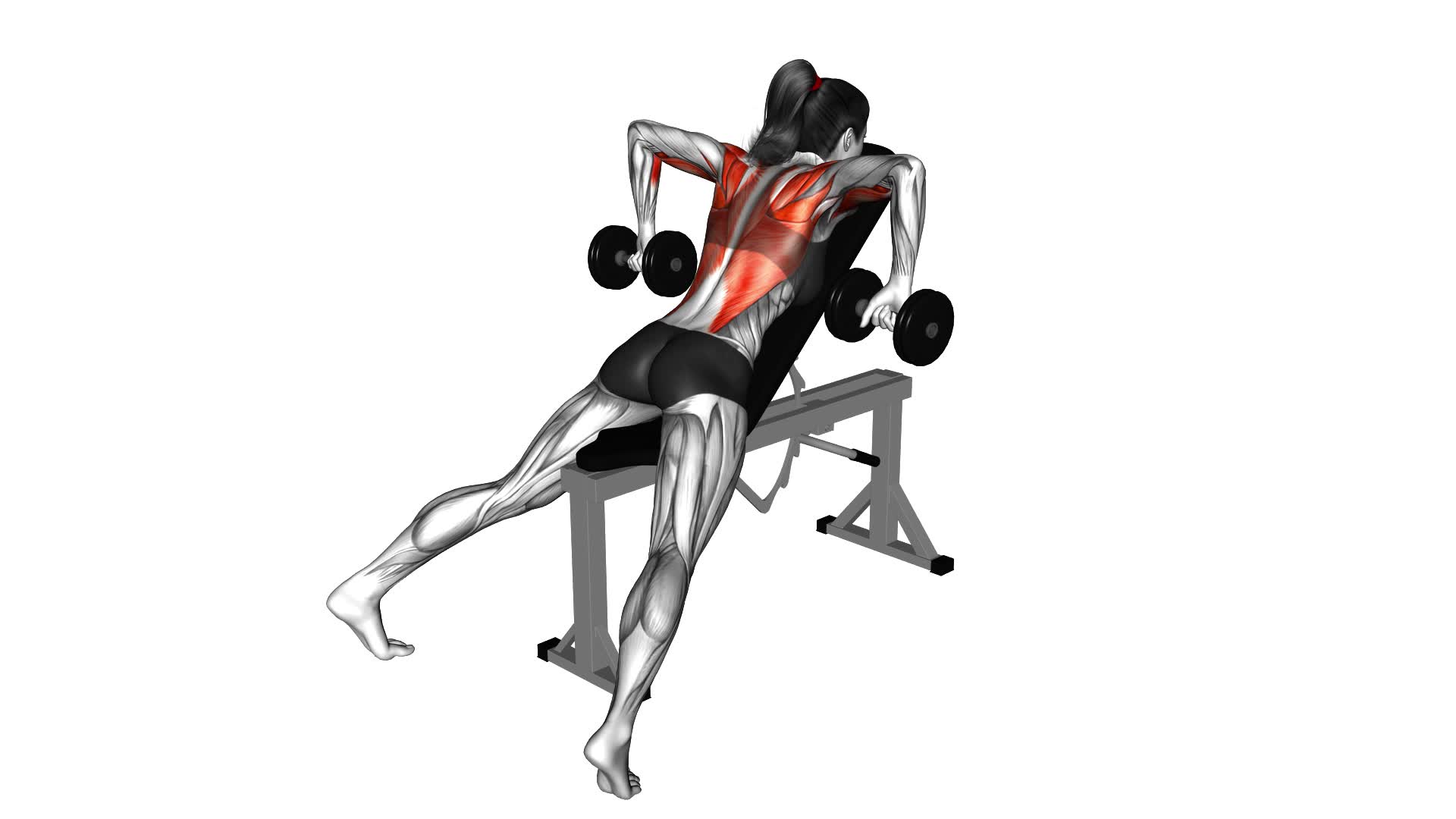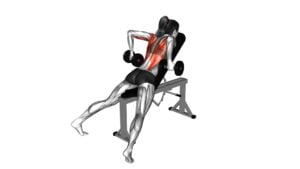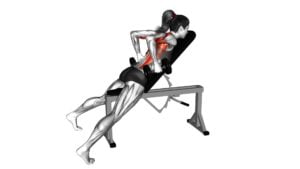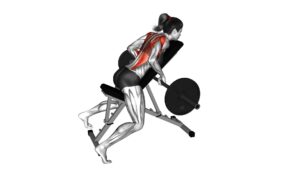Dumbbell Incline Row (female) – Video Exercise Guide & Tips

Looking to tone your back muscles? The dumbbell incline row is a great exercise for you. In this video exercise guide, we'll show you the proper technique and provide helpful tips for performing this exercise effectively.
Watch This Exercise Video
You'll learn how to set up the equipment, avoid common mistakes, and make progress in your workouts. Get ready to strengthen and sculpt your back with the dumbbell incline row.
Let's get started!
Key Takeaways
- Targets upper back muscles such as rhomboids, trapezius, and rear deltoids
- Strengthens and tones back muscles
- Improves posture
- Enhances overall physique
Benefits of the Dumbbell Incline Row
There are 5 key benefits of the Dumbbell Incline Row that you can experience when incorporating it into your workout routine.
First and foremost, this exercise is excellent for muscular development. By targeting the muscles in your upper back, including the rhomboids, trapezius, and rear deltoids, the Dumbbell Incline Row helps to strengthen and tone these areas. This not only enhances your overall physique but also improves your posture.
Speaking of posture, the Dumbbell Incline Row is highly effective in correcting and improving it. Many people suffer from poor posture due to factors like sitting for long hours or constantly hunching over electronic devices. This exercise helps counteract the effects of these habits by strengthening the muscles responsible for maintaining an upright posture. As a result, you'll stand taller, with your shoulders back and chest lifted.
Incorporating the Dumbbell Incline Row into your workout routine is a smart choice for anyone looking to develop their muscles and improve their posture. However, to maximize the benefits of this exercise, it's important to use the proper equipment and set-up.
Proper Equipment and Set-Up
To ensure optimal results from the Dumbbell Incline Row, what equipment should you use and how should you set it up? Proper equipment and set-up are crucial for performing the Dumbbell Incline Row effectively and safely. The first thing you'll need is an incline bench set to a 45-degree angle. This angle allows for maximum activation of the upper back muscles. Place the bench in an open space where you have enough room to move your arms freely without any obstructions.
Next, select the appropriate dumbbells for your fitness level. The weight you choose should challenge you but still allow you to maintain proper form throughout the exercise. It's important to note that using weights that are too heavy can compromise your form and increase the risk of injury. On the other hand, using weights that are too light may not provide enough resistance to effectively target the muscles. Start with a lighter weight and gradually increase as you become stronger and more comfortable with the exercise.
Having the proper equipment and setting it up correctly are essential for performing the Dumbbell Incline Row safely and effectively. Now that you know what equipment to use and how to set it up, let's move on to the step-by-step guide to performing the exercise.
Step-by-Step Guide to Performing the Exercise
To perform the Dumbbell Incline Row effectively, you'll need to follow these step-by-step instructions:
- Start by adjusting the incline bench to a 45-degree angle.
- Place a dumbbell on each side of the bench.
- Lie face down on the bench with your chest and stomach pressed against it.
- Reach down and grab the dumbbells with an overhand grip.
- With your arms fully extended, pull the dumbbells up towards your chest, squeezing your shoulder blades together.
- Lower the dumbbells back down slowly and repeat for the desired number of repetitions.
The Dumbbell Incline Row primarily targets the muscles in your upper back, including the rhomboids, trapezius, and rear deltoids. It also engages your biceps and forearms as secondary muscles.
Common errors to avoid when performing this exercise include:
- Using too much weight and sacrificing proper form.
- Rounding your shoulders or arching your back.
- Not fully extending your arms at the bottom of the movement.
- Using momentum to lift the dumbbells instead of relying on your muscles.
- Jerking the weights up instead of maintaining a controlled movement.
Common Mistakes to Avoid
To avoid common mistakes when performing the Dumbbell Incline Row, you should focus on maintaining proper form and avoiding excessive weight. One common mistake is using too much weight, which can compromise your form and increase the risk of injury. It's important to choose a weight that allows you to perform the exercise with proper technique.
Another common mistake is rounding your back during the movement. This can put unnecessary strain on your lower back and decrease the effectiveness of the exercise. Instead, keep your back straight and engage your core muscles to maintain stability.
Additionally, avoid using momentum to lift the dumbbells. This can take the focus away from the targeted muscles and reduce the overall effectiveness of the exercise. Instead, focus on controlled and deliberate movements, squeezing your shoulder blades together at the top of the movement.
Tips for Progression and Variation
To progress and vary your Dumbbell Incline Row workout, try incorporating different grip variations and increasing the weight gradually. This will help you challenge your muscles in new ways and continue to see progress. Here are some tips for progression techniques and modified variations:
- Overhand Grip: Start by using an overhand grip, with your palms facing down. This grip targets your back muscles more specifically.
- Underhand Grip: Switch to an underhand grip, with your palms facing up. This grip puts more emphasis on your biceps and helps to develop a stronger mind-muscle connection.
- Alternating Grip: Try using an alternating grip, with one palm facing up and the other facing down. This grip helps to improve grip strength and overall stability.
Increase Weight Gradually: As you become comfortable with the exercise, gradually increase the weight of the dumbbells. This will continue to challenge your muscles and promote growth.
Modified Variations: To add variety to your workout, you can try performing the Dumbbell Incline Row on an adjustable bench set at a higher incline. This will target your upper back and rear delts more effectively.
Frequently Asked Questions
How Many Sets and Reps Should I Do for the Dumbbell Incline Row?
For the dumbbell incline row, it's important to consider the number of sets and reps you should do. To determine this, you need to consider your fitness goals and current strength level.
Generally, a good starting point would be 3-4 sets of 8-12 reps. This allows for enough volume to stimulate muscle growth and strength development.
However, it's always a good idea to consult with a fitness professional for personalized recommendations based on your specific needs and abilities.
Can I Do the Dumbbell Incline Row if I Have a Shoulder Injury?
If you have a shoulder injury, it's important to modify the dumbbell incline row exercise. You can try using lighter weights or reducing the range of motion to avoid putting too much strain on your shoulder.
Alternatively, you can opt for alternative exercises that target the same muscle groups without aggravating your injury.
Consult with a healthcare professional or a certified trainer to determine the best modifications or alternatives for your specific shoulder injury.
Is It Necessary to Warm up Before Performing the Dumbbell Incline Row?
Before performing the dumbbell incline row, it's necessary to warm up. Warming up has many benefits, such as increasing blood flow to the muscles and preparing them for exercise. It also helps to prevent injury and improve performance.
However, it's important to avoid common mistakes while performing this exercise. Make sure to maintain proper form, engage your core, and avoid using excessive weight. Taking these precautions will ensure a safe and effective workout.
Can I Incorporate the Dumbbell Incline Row Into My Full-Body Workout Routine?
Yes, you can definitely incorporate the dumbbell incline row into your full-body workout routine. This exercise targets your back muscles, helping to build strength and improve posture. The incline position also engages your core and stabilizing muscles.
To add variation, you can try using different grip widths or alternating arms. The benefits of incorporating the dumbbell incline row include improved upper body strength, increased muscle definition, and enhanced overall athletic performance.
How Long Should I Rest Between Sets When Doing the Dumbbell Incline Row?
When doing the dumbbell incline row, it's important to consider the rest duration between sets. Resting for the appropriate amount of time allows your muscles to recover and perform at their best.
To optimize your results, aim for a rest period of around 60-90 seconds between sets. This will give your muscles enough time to recover while still maintaining the intensity of your workout.
Remember to also focus on maintaining proper form throughout each rep to maximize the effectiveness of the exercise.
Conclusion
In conclusion, the dumbbell incline row is a highly effective exercise for females looking to strengthen their upper body muscles.
By using proper equipment and following the step-by-step guide, you can perform this exercise correctly and avoid common mistakes.
Remember to focus on proper form and gradually increase the weight for progression.
With dedication and consistency, you'll see improvements in your strength and muscle definition.

Author
Years ago, the spark of my life’s passion ignited in my mind the moment I stepped into the local gym for the first time. The inaugural bead of perspiration, the initial endeavor, the very first surge of endorphins, and a sense of pride that washed over me post-workout marked the beginning of my deep-seated interest in strength sports, fitness, and sports nutrition. This very curiosity blossomed rapidly into a profound fascination, propelling me to earn a Master’s degree in Physical Education from the Academy of Physical Education in Krakow, followed by a Sports Manager diploma from the Jagiellonian University. My journey of growth led me to gain more specialized qualifications, such as being a certified personal trainer with a focus on sports dietetics, a lifeguard, and an instructor for wellness and corrective gymnastics. Theoretical knowledge paired seamlessly with practical experience, reinforcing my belief that the transformation of individuals under my guidance was also a reflection of my personal growth. This belief holds true even today. Each day, I strive to push the boundaries and explore new realms. These realms gently elevate me to greater heights. The unique combination of passion for my field and the continuous quest for growth fuels my drive to break new ground.



